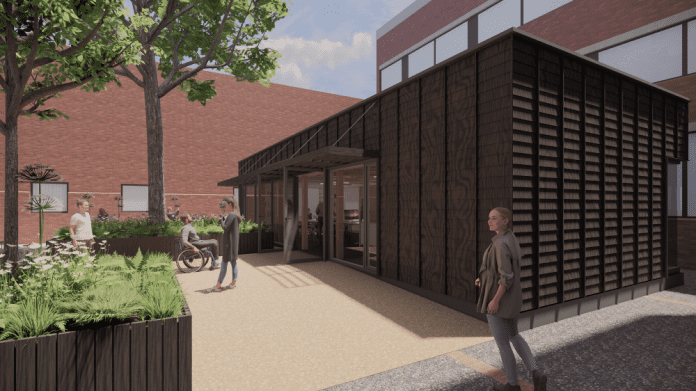Manchester City Council has given the green light for a new, low-carbon, timber and straw Robotics Living Lab Pavilion at Manchester Fashion Institute
Designed by Bennetts Associates, the pavilion aligns with sustainability goals and supports micro-scale fashion businesses using robotic technologies.
Designed as a single-storey, timber-framed building, the pavilion will provide an adaptable workspace and exhibition and events space for the Robotics Living Lab to promote and showcase its work and research.
The new pavilion will help to support micro-scale fashion businesses using robotics
The Robotics Living Lab Pavilion aligns with both Manchester Metropolitan University’s sustainability targets and Greater Manchester’s Zero Carbon Manchester 2038 plan.
The structure integrates biogenic and regenerative materials that sequester carbon during their production or lifecycle.
Timer frame has been used to reduce initial carbon emissions
A UK Douglas fir timber frame has been used in the design, which diminishes initial carbon emissions.
Additionally, straw-insulated wall panels efficiently store carbon, achieving this in a shorter timeframe compared to conventional sequestering materials.
The exposed timber frame takes the form of an expressive waffle soffit structure, enhancing the internal space.
Developing sustainable and local fashion manufacturing skills for Manchester
Susan Postlethwaite, professor of Fashion Technologies at MFI and director of the Robotics Living Lab, said: “I am delighted to be working with Bennetts Associates to develop a low carbon design for the ‘work in progress’ space.
“This beautiful structure will help support us in showcasing and draw attention to the important work of RoLL as part of the AHRC funded CResCa World Class Lab which will help develop sustainable and local fashion manufacturing skills for Manchester and the region.”
Sam Gills, architect at Bennetts Associates said, “The pavilion meets the Manchester Metropolitan University’s climate commitments entirely, embedding circularity and low carbon design whilst also acting as a landmark space on the All Saints campus for fashion designers and manufacturers.”

















